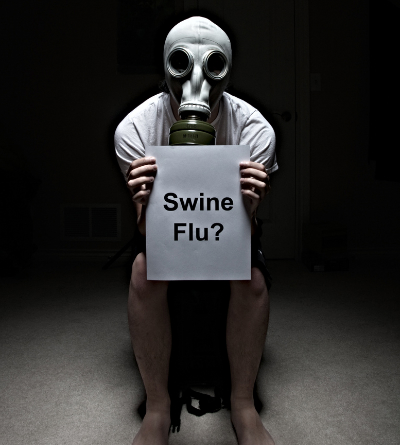I agree with the calls for some amount of caution in the search for a smoking gun in the swine flu pandemic. There’s always the danger of over-reaching and turning your target into an object of sympathy. But really, the science IS behind us on this one. The head virologist of the CDC has indeed identified the core strain of this outbreak as one that arose in a North Carolina CAFO. Meanwhile, another voice, this time Johann Hari of the London Independent (via HuffPo) convincingly touts the idea that our desire for cheap meat is a cause of the current crisis. He very elegantly describes how factory farms manufacture potent viruses along with their cheap meat:
To understand how this happens, you have to compare two farms. My grandparents had a pig farm in the Swiss mountains, with around twenty swine at any one time. What happened there if, in the bowels of one of their pigs, a virus mutated and took on a deadlier form? At every stage, the virus would meet stiff resistance from the pigs’ immune systems. They were living in fresh air, on the diet they evolved with, and without stress – so they had a robust ability to fight back. If the virus did take hold, it would travel only as far as the sick hog could walk. So if the virus would then have around twenty other pigs to spread and mutate in – before it would hit the end of its own evolutionary path, and die off.
Secure · Tax deductible · Takes 45 SecondsSecure · Tax deductible · Takes 45 SecondsIf it was a really lucky, plucky virus, it might make it to market – where it would come up against more healthy pigs living in small herds. It has little opportunity to fan out across a large population of pigs or evolve a strain that could be transmitted to humans.
Now compare this to what happens when a virus evolves in a modern factory farm. In most swine farms today, six thousand pigs are crammed snout-to-snout in tiny cages where they can barely move, and are fed for life on an artificial pulp, while living on top of cess-pools of their own stale faeces.
Instead of having just twenty pigs to experiment and evolve in, the virus now has a pool of thousands, constantly infecting and reinfecting each other. The virus can combine and recombine again and again. The ammonium from the waste they live above burns the pigs’ respiratory tracts, making it easier yet for viruses to enter them. Better still, the pigs’ immune systems are in free-fall. They are stressed, depressed, and permanently in panic, making them far easier to infect. There is no fresh air or sunlight to bolster their natural powers of resistance. They live in air thick with viral loads, and they are exposed every time they breathe in.
You cannot repeat enough the idea that factory farms/CAFOs are comprised of (in the case of the Mexican farm) hundreds of thousands of immuno-compromised animals — the perfect breeding ground for viruses. While it’s true that a virus might emerge in a small farm, the animals there are healthier and better able to defeat it. You don’t need to enter a small farm in a clean suit. A small farm does not have a sophisticated “biosecurity manual,” such as C. Larry Pope, Smithfield’s CEO, very proudly trumpeted during his appearance today on CNBC, to protect their pigs from contamination by humans. As Tom Philpott (and Hari later in his post) recounted, factory farms simply aren’t biosecure — it’s well established that pathogens can easily pass in and out. Hari himself quotes several experts — including the British government’s Chief Scientist — on the unequivocal pathogenic dangers of CAFOs.
For his part, Smithfield CEO Pope in his interview doubted that “they’ll ever find the source of this” outbreak. And given that his company controls access to the facility at the center of the pandemic, it’s possible that he’s knows what he’s talking about. He reported that Smithfield has given samples from pigs at the Veracruz facility to a Mexican lab for analysis — samples chosen by Smithfield, not by independent experts. We shouldn’t then be surprised at the ultimate absence of a smoking gun, but neither should we demand one. We know more than enough to assert that it’s time for the public to learn what those of us in the sustainable world have understood for a long time — CAFOs are public health hazards of the highest order. And it’s also time that the public started to openly question why CAFOs and their owners are able to so brazenly flout environmental law — even laws written specifically to regulate their operations. When you look at the totality of the evidence, I don’t think it’s fair to say that WE’RE the ones who’ve over-reached.



